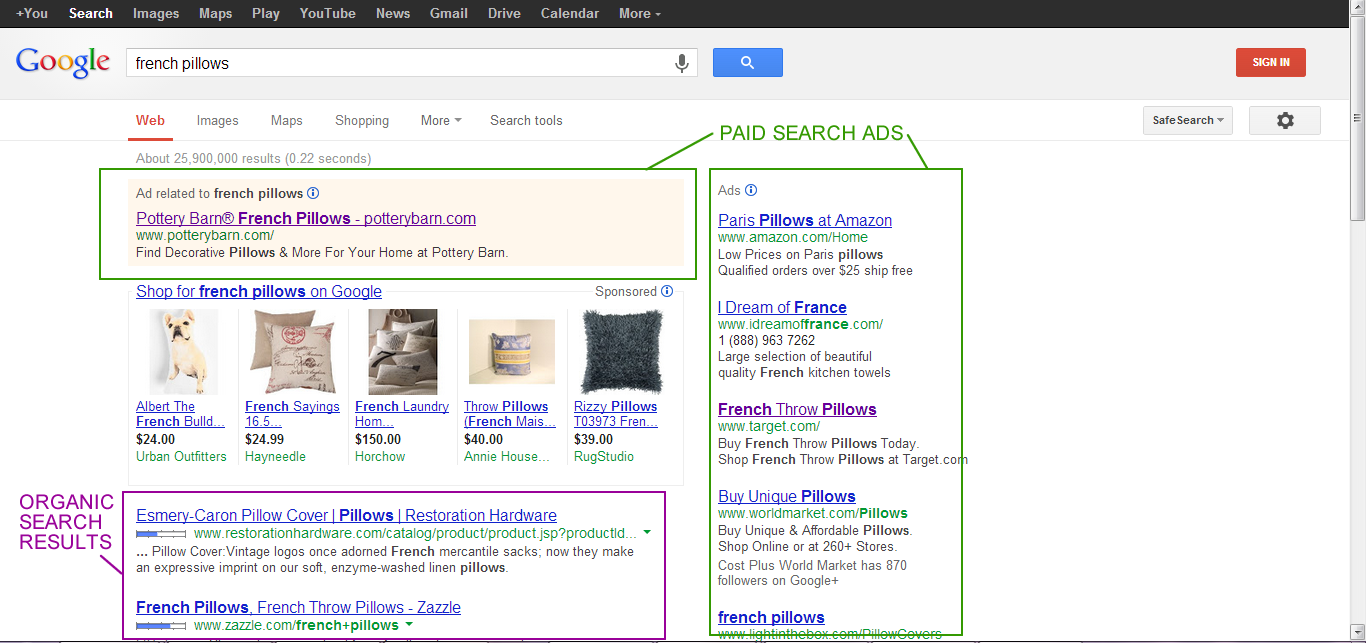Last week, this series started off with an introduction to SEO, now we?ll help you get acquainted with SEM and PPC. Since you?ve optimized your site, now it?s time to actively recruit customers. You can do this with paid search, or online advertising.
When you search for something using a search engine, whether that?s Google or Bing, there are two kinds of results: there are the organic results (free) and the ads (paid results). Organic results are determined by a combination of URL chosen, content, tags, links, etc.; and paid results are just that: paid for.
SEM stands for Search Engine Marketing. It is most often referring to paid search, whereas SEO (search engine optimization) is related to your organic results. PPC, which stands for Pay-Per-Click advertising, is the format in which ads are purchased on the main search engines. Generally, you pay for every click that comes through to your site, regardless of conversion.
You can see in the example that the associated ads and organic results that came up in the sample search for ?French pillows.? The highest-ranking ones are those that include the keyword phrase in the ad. Some of the ads are just for pillows and not ?French pillows.? You probably wouldn?t click on that ad if you were looking for this specific type of pillow.
When you?re paying for clicks, you should consider filtering out keywords and geographic areas that may be too broad (more on that later), or you could end up paying for lots of clicks that aren?t relevant to your business.
Here are some easy steps to get started with paid search:
1. Make a keyword list
As a small business, chances are, you?re working with a pretty limited ad budget. Think about what you might type in to find your product or service, or ask a friend what comes to mind. Come up with a small list of keywords to get started. If you were selling French pillows, as in the example below, you might use that keyword, but you may also use: ?vintage French pillows,? ?antique French pillows,? ?French country pillows? and ?French throw pillows.?

Using the word pillow on its own with a limited budget is not the best idea, as that broad keyword will be more expensive (due to lots of competition) and in very high volume; you?d use up your entire budget on people doing broad searches rather than looking for your specific product.
You can do some keyword research using Google Trends and Google Adwords Keyword Tool to see volume of search and competition.
2. Consider the geographic target of your campaigns
Start with targeting ads that are specific to the locations you ship to. If you?re a local business, you may only want your ad to show in a specific geographic area, for example within a certain distance from your physical location, or perhaps within your state, depending on your business. You?ll be wasting your ad dollars by showing ads for a local coffee shop in Pennsylvania to a person searching in California!
3. Competitive Analysis
Do some competitive analysis. Search some of the keywords you would like to target and see what the other ads say. You want to stand out from the crowd while appealing to your customers. Your business provides something great. Tell your customers what that is.
4. Write some sample search ad copy
One of the hardest things about writing search ad copy is saying what you want to say in a compelling and attractive way, while working within the character limits for each Search Engine. Google AdWords limits are 25 characters for the title, 35 characters for the ad, and another 35 characters for the call to action (call now, try it free, etc.). All counts include spaces. So you can see it?s not much space to work with. Be succinct, use capitalization and punctuation thoughtfully, and keep in mind that lots of repetition and caps will not be accepted.
5. Start bidding
Set your monthly budget for each campaign. Then, after doing research on average bids for your keywords, set your maximum bid. You?ll start seeing an increase in traffic to your site. If the bid systems in Google AdWords and Bing seem too confusing, you can also consider using a campaign management tool like SiteWit (which is easy-to-use and tailored for small businesses) or Marin Software. Whatever method you choose, keep a watchful eye on the success of your ads, and don?t pay for ads or keywords that aren?t providing returns on your investment.
Source: http://www.yola.com/blog/seo-sem-and-ppc-an-easy-intro-for-small-business-part-2/
safety not guaranteed lifehouse al gore la dodgers lawrence o donnell magic johnson jetblue pilot
No comments:
Post a Comment
Note: Only a member of this blog may post a comment.